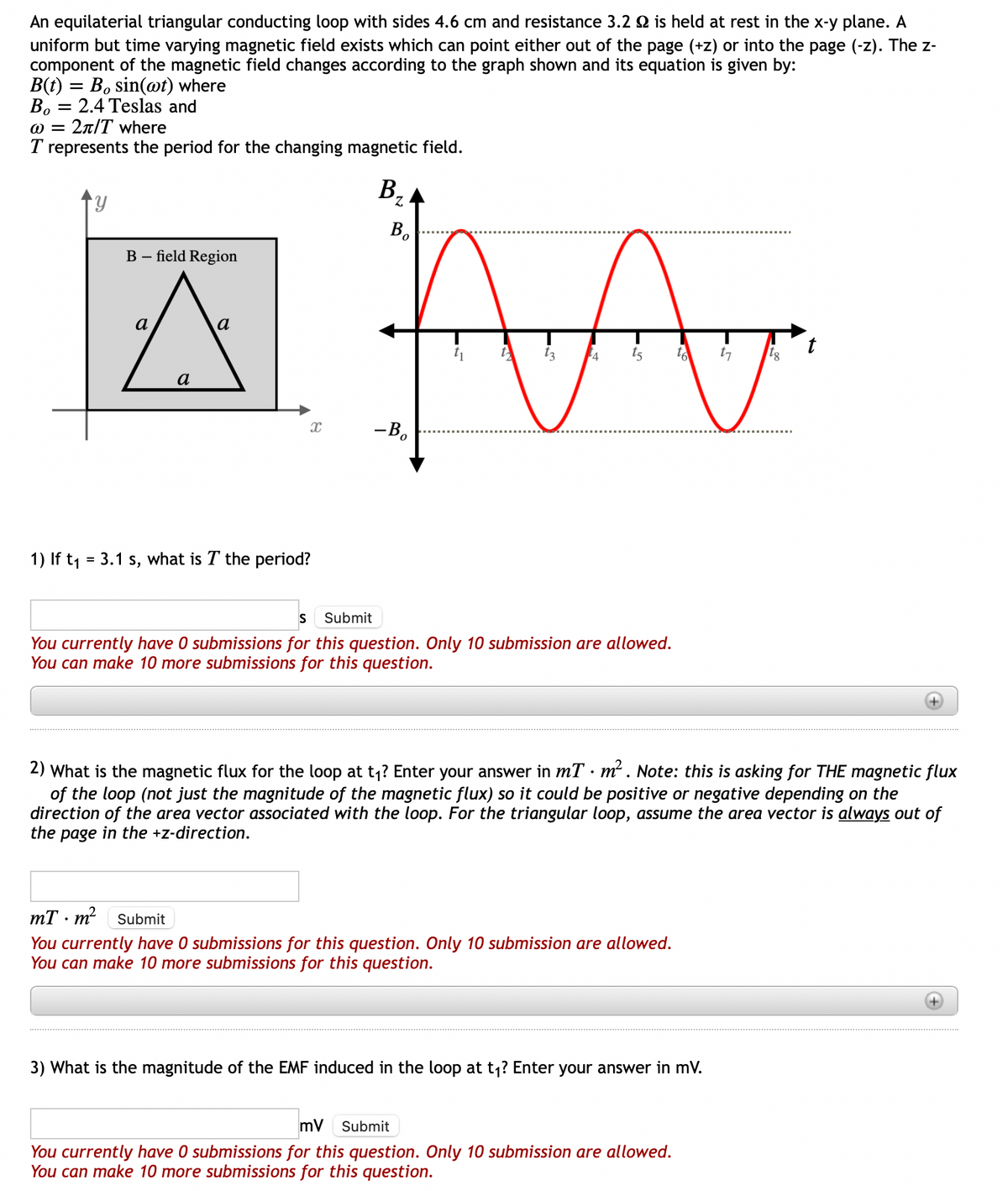An equilaterial triangular conducting loop with sides 4.6 cm and resistance 3.2 is held at rest in the x-y plane. A uniform but time varying magnetic field exists which can point either out of the page (+z) or into the page (-z). The z- component of the magnetic field changes according to the graph shown and its equation is given by: B(t)= Bo sin(wt) where B, 2.4 Teslas and = @= 2π/T where T represents the period for the changing magnetic field. B₂ B-field Region a a X 1) If t₁ = 3.1 s, what is T the period? MA t3 4 to Bo -Bo S Submit You currently have 0 submissions for this question. Only 10 submission are allowed. You can make 10 more submissions for this question. . mT m² Submit You currently have 0 submissions for this question. Only 10 submission are allowed. You can make 10 more submissions for this question. 2) What is the magnetic flux for the loop at t₁? Enter your answer in mT m². Note: this is asking for THE magnetic flux of the loop (not just the magnitude of the magnetic flux) so it could be positive or negative depending on the direction of the area vector associated with the loop. For the triangular loop, assume the area vector is always out of the page in the +z-direction. 3) What is the magnitude of the EMF induced in the loop at t₁? Enter your answer in mV. 17 mV Submit You currently have 0 submissions for this question. Only 10 submission are allowed. You can make 10 more submissions for this question. tg t
An equilaterial triangular conducting loop with sides 4.6 cm and resistance 3.2 is held at rest in the x-y plane. A uniform but time varying magnetic field exists which can point either out of the page (+z) or into the page (-z). The z- component of the magnetic field changes according to the graph shown and its equation is given by: B(t)= Bo sin(wt) where B, 2.4 Teslas and = @= 2π/T where T represents the period for the changing magnetic field. B₂ B-field Region a a X 1) If t₁ = 3.1 s, what is T the period? MA t3 4 to Bo -Bo S Submit You currently have 0 submissions for this question. Only 10 submission are allowed. You can make 10 more submissions for this question. . mT m² Submit You currently have 0 submissions for this question. Only 10 submission are allowed. You can make 10 more submissions for this question. 2) What is the magnetic flux for the loop at t₁? Enter your answer in mT m². Note: this is asking for THE magnetic flux of the loop (not just the magnitude of the magnetic flux) so it could be positive or negative depending on the direction of the area vector associated with the loop. For the triangular loop, assume the area vector is always out of the page in the +z-direction. 3) What is the magnitude of the EMF induced in the loop at t₁? Enter your answer in mV. 17 mV Submit You currently have 0 submissions for this question. Only 10 submission are allowed. You can make 10 more submissions for this question. tg t
Related questions
Question
100%

Transcribed Image Text:An equilaterial triangular conducting loop with sides 4.6 cm and resistance 3.2 is held at rest in the x-y plane. A
uniform but time varying magnetic field exists which can point either out of the page (+z) or into the page (-z). The z-
component of the magnetic field changes according to the graph shown and its equation is given by:
B(t)= Bo sin(wt) where
B, 2.4 Teslas and
=
@= 2π/T where
T represents the period for the changing magnetic field.
B₂
B-field Region
a
a
X
1) If t₁ = 3.1 s, what is T the period?
MA
t3 4
to
Bo
-Bo
S Submit
You currently have 0 submissions for this question. Only 10 submission are allowed.
You can make 10 more submissions for this question.
.
mT m² Submit
You currently have 0 submissions for this question. Only 10 submission are allowed.
You can make 10 more submissions for this question.
2) What is the magnetic flux for the loop at t₁? Enter your answer in mT m². Note: this is asking for THE magnetic flux
of the loop (not just the magnitude of the magnetic flux) so it could be positive or negative depending on the
direction of the area vector associated with the loop. For the triangular loop, assume the area vector is always out of
the page in the +z-direction.
3) What is the magnitude of the EMF induced in the loop at t₁? Enter your answer in mV.
17
mV Submit
You currently have 0 submissions for this question. Only 10 submission are allowed.
You can make 10 more submissions for this question.
tg
t
Expert Solution
This question has been solved!
Explore an expertly crafted, step-by-step solution for a thorough understanding of key concepts.
This is a popular solution!
Trending now
This is a popular solution!
Step by step
Solved in 4 steps
